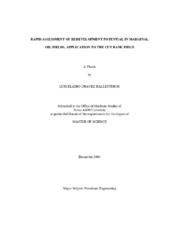| dc.description.abstract | Quantifying infill potential in marginal oil fields often involves several challenges. These include highly heterogeneous reservoir quality both horizontally and vertically, incomplete reservoir databases, considerably large amounts of data involving numerous wells, and different production and completion practices. The most accurate way to estimate infill potential is to conduct a detailed integrated reservoir study, which is often time-consuming and expensive for operators of marginal oil fields. Hence, there is a need for less-demanding methods that characterize and predict heterogeneity and production variability. As an alternative approach, various authors have used empirical or statistical analyses to model variable well performance. Many of the methods are based solely on the analysis of well location, production and time data.
My objective is to develop an enhanced method for rapid assessment of infill-drilling potential that would combine increased accuracy of simulation-based methods with times and costs associated with statistical methods. My proposed solution is to use reservoir simulation combined with automatic history matching to regress production data to determine the permeability distribution. Instead of matching on individual cell values of reservoir properties, I match on constant values of permeability within regions around each well. I then use the permeability distribution and an array of automated simulation predictions to determine infill drilling potential throughout the reservoir.
Infill predictions on a single-phase synthetic case showed greater accuracy than results from statistical techniques. The methodology successfully identified infill well locations on a synthetic case derived from Cut Bank field, a water-flooded oil reservoir. Analysis of the actual production and injection data from Cut Bank field was unsuccessful, mainly because of an incomplete production database and limitations in the commercial regression software I used.
In addition to providing more accurate results than previous empirical and statistical methods, the proposed method can also incorporate other types of data, such as geological data and fluid properties. The method can be applied in multiphase fluid situations and, since it is simulation based, it provides a platform for easy transition to more detailed analysis. Thus, the method can serve as a valuable reservoir management tool for operators of stripper oil fields. | en |


